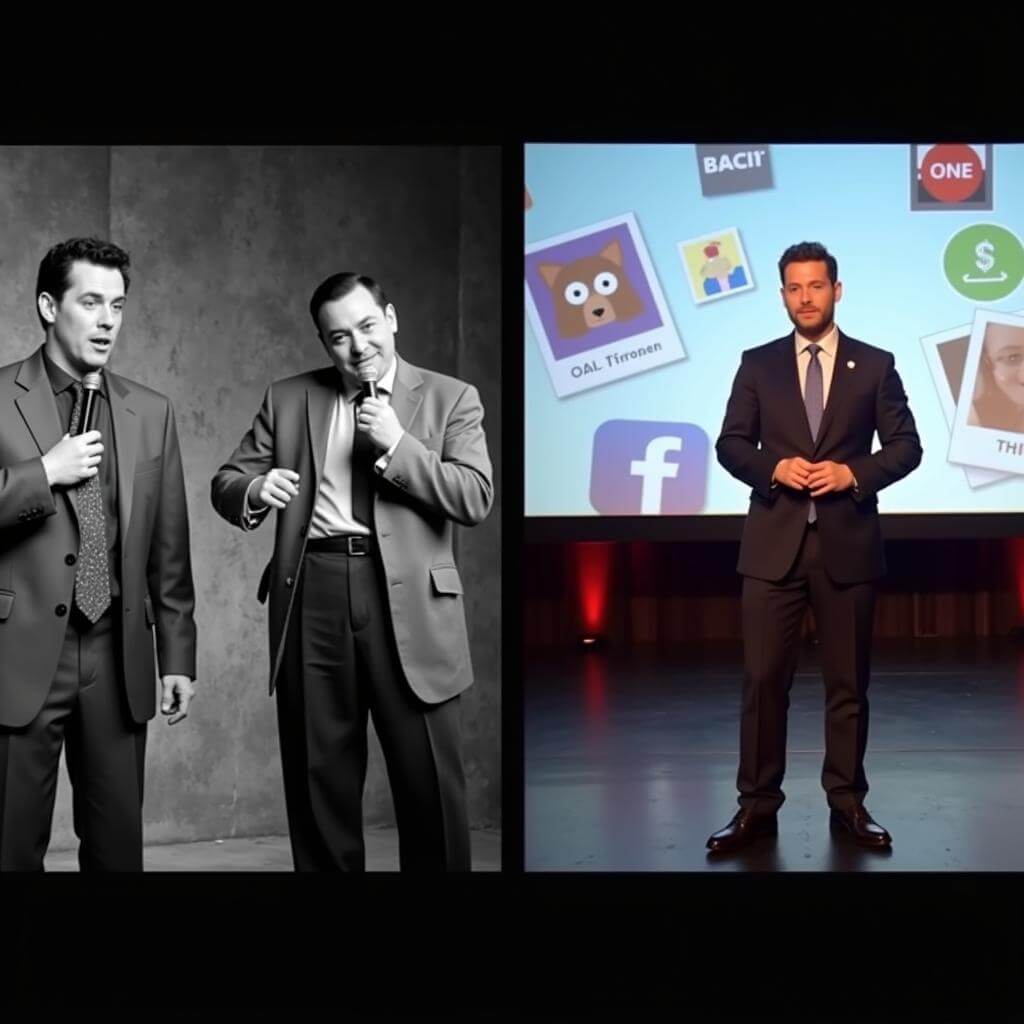The ability to vividly describe a funny situation is a valuable skill for the IELTS Speaking test. This topic has appeared frequently in past exams and is likely to continue being a popular choice for examiners. Let’s explore how to effectively tackle this question and boost your speaking score.
Part 1: Introduction and Interview
In Part 1, the examiner may ask general questions about humor and laughter. Here are some common questions you might encounter:
- Do you like to make people laugh?
- What kind of things make you laugh?
- Do you think it’s important to have a good sense of humor?
Let’s look at a sample answer for the first question:
Examiner: Do you like to make people laugh?
Band 6-7 Answer:
“Yes, I do enjoy making people laugh. I think it’s a great way to connect with others and create a positive atmosphere. Sometimes I tell jokes or funny stories to my friends and family, and it feels good when they laugh along.”
Band 8-9 Answer:
“Absolutely! I find immense satisfaction in eliciting laughter from others. Not only does it foster a sense of camaraderie, but it also serves as a powerful tool for breaking the ice in social situations. I often employ self-deprecating humor or share amusing anecdotes from my daily life, which seem to resonate well with my audience. There’s something truly rewarding about brightening someone’s day with a well-timed quip or a humorous observation.”
 IELTS Speaking Examiner asking a question
IELTS Speaking Examiner asking a question
Part 2: Long Turn
Here’s a sample cue card related to describing a situation that made you laugh:
Describe a situation that made you laugh
You should say:
- When and where it happened
- Who you were with
- What exactly happened
- And explain why you found it so funnyBand 6-7 Answer:
“I’d like to talk about a funny situation that happened last summer when I was on vacation with my family. We were at a beach resort, and my younger brother decided to try surfing for the first time. He was really excited and confident, but as soon as he got on the board, he lost his balance and fell into the water. He kept trying, but he just couldn’t stay on the board for more than a few seconds. What made it even funnier was that he was wearing these bright yellow swim trunks that made him look like a rubber duck bobbing in the waves. We all couldn’t stop laughing, including my brother. It was just one of those moments where everything came together to create a hilarious scene. I found it so funny because it was such a contrast between his confidence before getting on the board and his complete lack of skill once he was in the water. Plus, the image of him in those yellow trunks was just priceless. It’s a memory that still makes us all laugh whenever we talk about it.”
Band 8-9 Answer:
“I’d be delighted to recount an utterly hilarious situation that occurred during a team-building event at my company last spring. We were participating in an impromptu talent show, and my usually reserved colleague, Mark, decided to showcase his ‘hidden talent’ for magic tricks.
The event took place in our office’s spacious conference room, transformed into a makeshift stage for the occasion. As Mark stepped up to perform, the atmosphere was thick with anticipation. He began with a classic card trick, exuding an air of confidence that was quite uncharacteristic of his normal demeanor.
However, things took a comical turn when he attempted his grand finale – the infamous ‘sawing a person in half’ illusion. He called upon our CEO as a volunteer, which already elicited nervous chuckles from the audience. As Mark dramatically flourished his prop saw, he accidentally snagged the CEO’s designer tie, causing it to unravel spectacularly.
The sheer unexpectedness of the situation, coupled with the stark contrast between Mark’s serious expression and the absurdity of the unfolding events, sent waves of laughter through the room. What amplified the humor was our CEO’s reaction – instead of being annoyed, he burst into hearty laughter, even using the remnants of his tie as an impromptu magic wand.
This incident was sidesplittingly funny for several reasons. Firstly, the juxtaposition of Mark’s earnest attempt at magic and the chaotic outcome was simply priceless. Secondly, it shattered the formal facade we usually maintain at work, revealing a more human and relatable side to our colleagues. Lastly, the CEO’s good-natured response transformed what could have been an awkward moment into a unifying experience for the entire team.
This comical episode not only provided much-needed comic relief but also fostered a sense of camaraderie among colleagues. It’s a perfect example of how unscripted moments of humor can break down barriers and create lasting memories in the workplace.”
 Funny magic trick gone wrong
Funny magic trick gone wrong
Follow-up questions:
- Do you think humor is important in daily life?
- How do different cultures perceive humor?
Band 6-7 Answer for Question 1:
“Yes, I believe humor is quite important in daily life. It helps people relax and cope with stress. Humor can also improve relationships by creating shared experiences and positive emotions. In my opinion, being able to laugh at everyday situations makes life more enjoyable and helps maintain a positive outlook.”
Band 8-9 Answer for Question 1:
“Absolutely, I firmly believe that humor plays a pivotal role in our daily lives. It serves as a powerful coping mechanism, enabling us to navigate life’s challenges with a lighter perspective. Moreover, humor acts as a social lubricant, facilitating smoother interactions and fostering deeper connections among individuals. It has the remarkable ability to defuse tense situations, boost creativity, and even enhance problem-solving skills by encouraging lateral thinking. From a physiological standpoint, laughter triggered by humor releases endorphins, promoting overall well-being and potentially boosting our immune system. In essence, incorporating humor into our daily routines can significantly enhance our quality of life, resilience, and interpersonal relationships.”
Part 3: Two-way Discussion
Examiner: How has humor in entertainment changed over the years?
Band 6-7 Answer:
“I think humor in entertainment has changed quite a bit over the years. In the past, it was often more straightforward and sometimes relied on physical comedy or simple jokes. Now, humor tends to be more complex and often involves social commentary or references to current events. Also, with the rise of social media and online platforms, there are many more ways for people to share and consume humor. This has led to the development of new forms of comedy, like memes and short funny videos.”
Band 8-9 Answer:
“The evolution of humor in entertainment has been quite fascinating and multifaceted. Over the decades, we’ve witnessed a significant shift in comedic paradigms. In earlier eras, humor often leaned towards slapstick and situational comedy, with a focus on physical gags and straightforward punchlines. However, as societal awareness and global connectivity have increased, we’ve seen a transition towards more nuanced and intellectually engaging forms of humor.
Contemporary comedy frequently incorporates layers of irony, satire, and meta-humor, often requiring a deeper understanding of cultural contexts and current affairs. This shift reflects our increasingly complex world and the audience’s appetite for more sophisticated content.
Moreover, the digital revolution has democratized humor creation and distribution. Social media platforms and content-sharing sites have given rise to new comedic formats like memes, GIFs, and short-form video content. These mediums allow for rapid dissemination of humor, often capitalizing on current events or pop culture phenomena in near real-time.
Another notable change is the growing sensitivity towards inclusive and politically correct humor. There’s a greater awareness of the potential impact of jokes on marginalized groups, leading to more thoughtful and socially conscious comedy.
Lastly, the globalization of entertainment has led to a cross-pollination of humor styles across cultures. We’re seeing an increasing appreciation for international comedy, which brings fresh perspectives and novel comedic approaches to global audiences.
In essence, the evolution of humor in entertainment mirrors the broader societal changes we’ve experienced, reflecting our changing values, technological advancements, and increasing global interconnectedness.”
 Evolution of humor in entertainment
Evolution of humor in entertainment
Key Vocabulary and Phrases for High Scores
-
Sidesplittingly funny /ˈsaɪdˌsplɪtɪŋli ˈfʌni/ (adjective): Extremely amusing or hilarious.
Example: “The comedian’s impersonations were sidesplittingly funny, leaving the audience in tears of laughter.” -
To elicit laughter /ɪˈlɪsɪt ˈlɑːftər/ (verb phrase): To draw out or evoke laughter from someone.
Example: “Her witty remarks never fail to elicit laughter from even the most serious crowd.” -
Self-deprecating humor /ˌself ˈdeprɪkeɪtɪŋ ˈhjuːmər/ (noun phrase): A form of humor that involves making fun of oneself.
Example: “His self-deprecating humor made him relatable and endearing to his audience.” -
To break the ice /breɪk ðə aɪs/ (idiom): To overcome initial awkwardness or tension in a social situation.
Example: “He used a funny anecdote to break the ice at the beginning of the meeting.” -
Unscripted moments /ʌnˈskrɪptɪd ˈməʊmənts/ (noun phrase): Spontaneous, unplanned occurrences.
Example: “Some of the most memorable moments in live television are the unscripted ones that catch everyone by surprise.”
Using these phrases and vocabulary in your IELTS Speaking responses can significantly enhance the quality and sophistication of your answers, potentially leading to higher scores.
Examiner’s Advice
To excel in the IELTS Speaking test, particularly when describing humorous situations:
- Practice narrating funny stories from your life, focusing on vivid descriptions and conveying your emotions.
- Expand your vocabulary related to humor and emotions. Use idiomatic expressions and advanced vocabulary where appropriate.
- Work on your timing and pacing. Ensure you can comfortably cover all points within the given time.
- Use a variety of grammatical structures and tenses to add complexity to your speech.
- Pay attention to your pronunciation and intonation, as they can greatly enhance the delivery of a humorous anecdote.
- Remember to relate your personal experience to broader themes when asked follow-up questions in Part 3.
By following these tips and continuously practicing, you can improve your ability to describe a person who has a unique sense of humor or any funny situation effectively in your IELTS Speaking test.
Remember, the key to a high score is not just in what you say, but how you say it. Confidence, fluency, and the ability to engage your listener are crucial factors. So, don’t just memorize answers, but practice expressing your thoughts naturally and engagingly.


